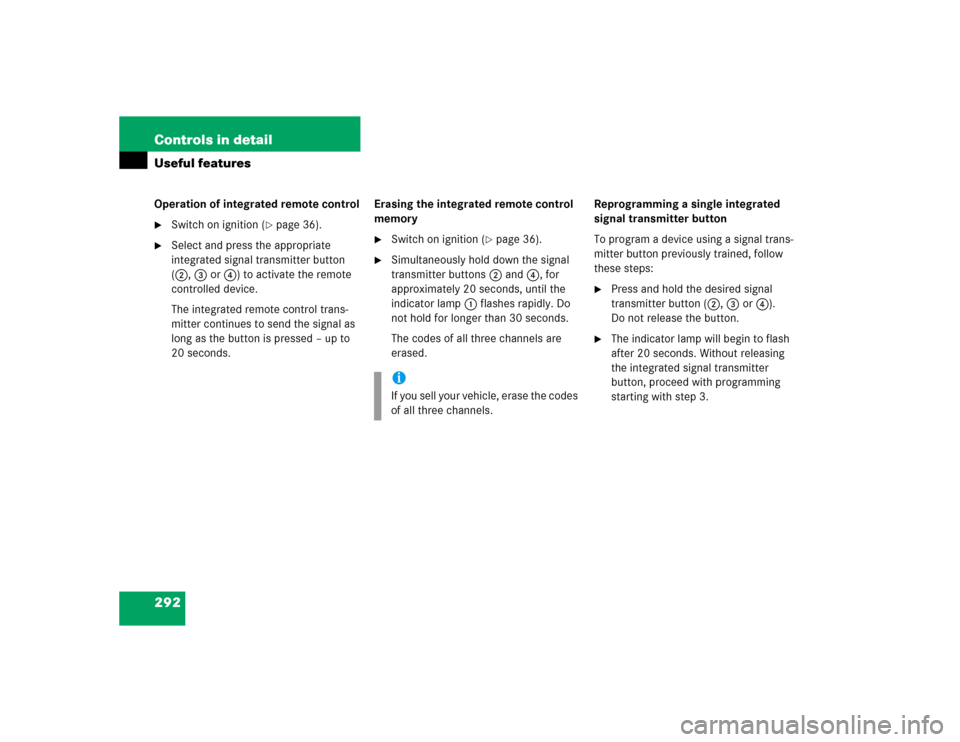Page 293 of 498

291 Controls in detail
Useful features
Step 12:�
Confirm the garage door operation by
pressing the programmed integrated
signal transmitter button (2, 3
or4).
Step 13:
�
To program the remaining two buttons,
repeat the steps above starting with
step 3.Gate operator/Canadian programming
Canadian radio-frequency laws require
transmitter signals to “time-out” (or quit)
after several seconds of transmission
which may not be long enough for the inte-
grated signal transmitter to pick up the sig-
nal during programming. Similar to this
Canadian law, some U.S. gate operators
are designed to “time-out” in the same
manner. If you live in Canada or if you are having dif-
ficulties programming a gate operator (re-
gardless of where you live) by using the
programming procedures, replace step 4
with the following:
Step 4:
�
Continue to press and hold the inte-
grated signal transmitter button (2,
3 or4) while you press and re-press
(“cycle”) your hand-held remote con-
trol transmitter6 every two seconds
until the frequency signal has been
learned. Upon successful training, the
indicator lamp1 will flash slowly and
then rapidly after several seconds.
�
Proceed with programming step 5 and
step 6 to complete.
Page 294 of 498

292 Controls in detailUseful featuresOperation of integrated remote control�
Switch on ignition (
�page 36).
�
Select and press the appropriate
integrated signal transmitter button
(2, 3 or4) to activate the remote
controlled device.
The integrated remote control trans-
mitter continues to send the signal as
long as the button is pressed – up to
20 seconds.Erasing the integrated remote control
memory
�
Switch on ignition (
�page 36).
�
Simultaneously hold down the signal
transmitter buttons2 and 4, for
approximately 20 seconds, until the
indicator lamp1 flashes rapidly. Do
not hold for longer than 30 seconds.
The codes of all three channels are
erased.Reprogramming a single integrated
signal transmitter button
To program a device using a signal trans-
mitter button previously trained, follow
these steps:
�
Press and hold the desired signal
transmitter button (2, 3 or4).
Do not release the button.
�
The indicator lamp will begin to flash
after 20 seconds. Without releasing
the integrated signal transmitter
button, proceed with programming
starting with step 3.
iIf you sell your vehicle, erase the codes
of all three channels.
Page 457 of 498

455 Technical terms
ABS
(A
ntilock B
rake S
ystem)
Prevents the wheels from locking up
during braking so that the vehicle can
continue to be steered.
Alignment bolt
Metal pin with thread. The centering
pin is an aid used when changing a tire
to align the wheel with the wheel hub.BAS
(B
rake A
ssist S
ystem)
System for potentially reducing braking
distances in emergency braking situa-
tions. The system is activated when it
senses an emergency based on how
fast the brake is applied.
Bi-Xenon headlamps*
Headlamps which use an electric arc as
the light source and produce a more in-
tense light than filament headlamps.
Bi-Xenon headlamps produce low
beam and high beam.CAC
(C
ustomer A
ssistance C
enter)
Mercedes-Benz customer service cen-
ter, which can help you with any ques-
tions about your vehicle and provide
assistance in the event of a break-
down.
CAN system
(C
ontroller A
rea N
etwork)
Data bus network serving to control ve-
hicle functions such as door locking or
windshield wiping.
Cockpit
All instruments, switches, buttons and
indicator/warning lamps in the passen-
ger compartment needed for vehicle
operation and monitoring.
Page 458 of 498

456 Technical termsCOMAND
(C
ockpit M
anagement and D
ata Sys-
tem)
Information and operating center for
vehicle sound and communications
systems, including the radio and the
navigation system, as well as other op-
tional equipment (CD changer, tele-
phone, etc.).
Control system
The control system is used to call up
vehicle information and to change
component settings. Information and
messages appear in the multifunction
display. The driver uses the buttons on
the multifunction steering wheel to
navigate through the system and to ad-
just settings.
Cruise control
Driving convenience system for auto-
matically maintaining the vehicle speed
set by the driver.Engine number
The number set by the manufacturer
and placed on the cylinder block to
uniquely identify each engine pro-
duced.
Engine oil viscosity
Measurement for the inner friction (vis-
cosity) of the oil at different tempera-
tures. The higher the temperature an
oil can tolerate without becoming thin,
or the lower the temperature it can tol-
erate without becoming viscous, the
better the viscosity.
ESP
(E
lectronic S
tability Pr
ogram)
Improves vehicle handling and direc-
tional stability.
ETD
(E
mergency T
ensioning D
evice)
Device which deploys in certain frontal
and rear collisions exceeding the sys-
tem's threshold to tighten the seat
belts.
->SRSFSS (Canada vehicles)
(F
lexible S
ervice S
ystem)
Maintenance service indicator in the
multifunction display that informs the
driver when the next vehicle mainte-
nance service is due. FSS evaluates en-
gine temperature, oil level, vehicle
speed, engine speed, distance driven
and the time elapsed since your last
maintenance service, and calls for the
next maintenance service accordingly.
Gear range
Number of gears which are available to
the automatic transmission for shifting.
The automatic gear shifting process
can be adapted to specific operating
conditions using the gear selector le-
ver.
GPS
(G
lobal P
ositioning S
ystem)
Satellite-based system for relaying
geographic location information to and
from vehicles equipped with special re-
ceivers. Employs CD digital maps for
navigation.
Page 460 of 498

458 Technical termsMultifunction steering wheel
Steering wheel with buttons for operat-
ing the control system.
OCS
(O
ccupant C
lassification S
ystem)
The system automatically turns the
front passenger front air bag on or off
based on the classified occupant size
category determined by weight sensor
readings from the seat.
Overspeed range
Engine speeds within the red marking
on the tachometer dial. Avoid this en-
gine speed range, as it may result in se-
rious engine damage that is not
covered by the Mercedes-Benz Limited
Warranty.Parktronic (Parking assist)*
System which uses visual and acoustic
signals to assist the driver during park-
ing maneuvers.
Poly-V-belt drive
Drives engine-components (alternator,
AC compressor, etc.) from the engine.
Power train
Collective term designating all compo-
nents used to generate and transmit
motive power to the drive axles, includ-
ing
�
engine
�
clutch/torque converter
�
transmission
�
transfer case
�
drive shaft
�
differential
�
axle shafts/axlesProgram mode selector switch
Used to switch the automatic transmis-
sion between standard operationS and
comfort operationC.
CLK 55 AMG with steering wheel gear-
shift control and manual shift program:
In addition toS andC (for standardS
or comfortC operation, see above) you
can use theM for manual shift
program.
Page 461 of 498

459 Technical terms
REST
(Residual engine heat utilization)
Feature that uses the engine heat
stored in the coolant to heat the vehi-
cle interior for a short time after the en-
gine has been turned off.
Restraint systems
Seat belts, child restraints, lower an-
chors and tethers for children (LATCH).
As independent systems, their protec-
tive functions complement one anoth-
er.RON
(R
esearch O
ctane N
umber)
The Research Octane Number for gaso-
line as determined by a standardized
method. It is an indication of a gaso-
line's ability to resist undesired detona-
tion (knocking). The average of both
the ->MON (Motor Octane Number)
and RON (Research Octane Number) is
posted at the pump, also known as
ANTI-KNOCK INDEX.Shift lock
When the vehicle is parked, this lock
prevents the gear selector lever from
being inadvertently moved out of
positionP without SmartKey turned
and brake pedal depressed.
Speedshift (CLK 500*, CLK 55 AMG)
Steering wheel gearshift control. You
can change the gears yourself with the
steering wheel gearshift buttons.
SRS
(S
upplemental R
estraint S
ystem)
Air bags, air bag control unit (with
crash sensor), emergency tensioning
device. Though independent systems,
they are closely interfaced to provide
effective occupant protection.
Page 476 of 498

474 Index
Maintenance service indicator 344
Parktronic system*
warning indicators 262
Seat belts 359
SRS 61, 359
Turn signals 25
Language
Multifunction display 150
Setting 150
LATCH child seat anchors 80
Folding back 81
Folding out 81
Layout of poly-V-belt drive 437
Leather upholstery
Cleaning 352
License plate lamps
Messages in display 383
Replacing bulbs 405, 410
Light alloy wheels
Cleaning 351
Technical data 440
Light sensor 383
Lighter see Cigarette lighterLighting 124
Automatic headlamp mode 125
Combination switch 129
Cornering fog lamps* 130
Daytime running lamp mode 126
Door entry lamps 133
Exterior lamp switch 124
Front fog lamps 128
High beam flasher 129
High beams 129
Instrument cluster illumination 134
Interior 132
Locator lighting 127
Low beam 124
Manual headlamp mode 125
Night security illumination 127
Parking lamps 124
Rear fog lamp 128
Settings (control system) 154
Limiting the gear range 168
Limp Home Mode 177
Line of fall 457Loading 264
Cargo tie-down rings 271
Instructions 269
Roof rack 264
Ski sack* 264
Split rear bench seat 267
Loading terminology 338
Loading the vehicle 319
Locator lighting 127
Setting 156
Lock buttons 457
Door handle (KEYLESS-GO*) 58
Locking 55, 94
Fuel filler flap 305
Global with KEYLESS-GO* 101
Global, SmartKey 96
The vehicle with KEYLESS-GO* 103
Vehicle in an emergency 398
Loss of Service and
Warranty Information Booklet 435
Loss of SmartKey 98
Loss of SmartKey
with KEYLESS-GO* 105
Page 479 of 498

477 Index
Parking brake 374
SmartKey with KEYLESS-GO* 381
Steering gear oil level 387
Sunroof* 388
Symbol messages 373–388
Tele Aid 386
Telephone* 388
Text messages 364–372
Trunk 388
Washer fluid 388
Multifunction
steering wheel 26, 138, 458
Buttons 138N
Navigation system
Operating 144
See separate COMAND*
operating instructions
Night security illumination 127
Normal occupant weight 339
Nubuck leather upholstery (CLK 55 AMG)
Cleaning 352
O
Occupant Classification System see OCS
Occupant distribution 339
Occupant safety 60
Air bags 61
Children and air bags 62
Children in the vehicle 70
Fastening the seat belts 43
Front passenger front
air bag off indicator lamp 77, 360
Infant and child restraint systems 70
LATCH child seat anchors 80
OCS 73
Seat belts 43, 64OCS 73, 458
Self-test 78
Odometer, main 25
Oil
Adding 312
Checking level 310
Consumption 309
Filler cap 312
Filler neck 312
Viscosity 456
Oil level
Checking 307
One-touch gearshifting 167
Canceling gear range limit 167
Downshifting 167
Upshifting 167